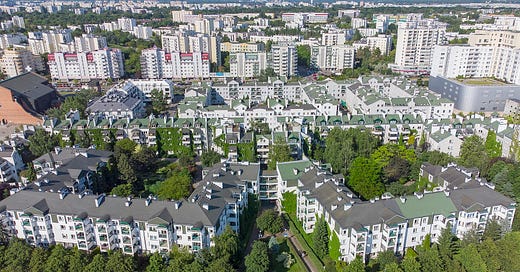Why does Eastern Europe build so many gated communities?
Warsaw has over 200 communities, but they're not what you think
Ordinarily when Americans or those in Western Europe think about gated communities, they picture manicured lawns and (Mc)mansions. The type of place only the very wealthy in society live in a safe, privatized bubble. Yet in countries across Central-Eastern Europe such communities are not only much more common, their form is much less inherently exclusionary.
Background
The video creator TypeAshton, an American living in Germany, released a well researched piece on how gated communities operate in the United States. She compared this to such communities in Germany, where they are still quite rare and often take on a much different character.
One thing which stood out to me is that in the US such gated communities are built to create security theatre. Large walls, security at the gates 24/7, all the amenities of normal communal life being brought in to the private enclave.. That is, if you’re wealthy enough. Many developments in the Carolinas and Georgia are springing up with gates at their entrance, but none of the amenities. No groceries, public pools, clinics, just housing. If a school is in the property it is likely private. To even write this almost makes my stomach turn with how such things come to be.
Designed for Inequality?
Gated communities exist primarily in cities or regions with very low-trust, perceptions of high crime, and wealth disparity. The weight each of these things have varies depending on the individual development, but what separates Eastern European developments from their US counterparts is form.
Across Central -Eastern Europe, ated communities most typically involve apartment buildings. Gates that open up to an apartment complex built during the 70s or 80s with clinics and other public amenities only a few blocks’ walk away. These communities emerged 30 years ago when the socialist governments collpased and millions were thrown into economic and physical uncertainty. Today these countries are very safe but back in the 90s crime was a major problem. Property crime, smuggling, petty corruption, gangsterism - the movie Brat has many contemporaries across the wider region.
The fundaamntal difference is that where these communities exist in the region, they are not fundamentally exclusionary of the wider public space. In spite of having 200 gated communities Poland’s capital of Warsaw is expanding its metro network and is able to have 2 suburban rail services. Gated communities may be a status symbol, but to live in one does not mean you orfeit the convenience of urban life. Whereas the Americans build these communities due to prceptions of crime, in Poland and other countris in the region they were built out of a genuine need for safety and that distinction matters.
The result of these differences is that while communities in Poland or Hungary or Czechia do have gates, they are still connected to a wider community. Public transit can still be supplied to these communities, even if not all residents use them. Apartment blocs of 8-10 stories with a park inside, tree-lined streets, community pools, schools, clinics, small shops right outside of their walls. Many were built in reaction to real events, 30 years later you are still able in Poland today to walk down the street or bike from a gatd apartment complex to grab food and wwalk home. You are not confined to a car, as in the United States.
Personally, the examples of gated communities in Central-Eastern Europe don’t strike me as particularly bad. When passing through the United States in areas where I do see them, especially as new developments, it really irks me. It seems inherently unsustainable. All this land could be used so much more effectively, aesthetically on the inside they look no different than any other suburban development … and yet the argument goes “like an HOA, property values are higher”. Home Owners Associations are a different topic, but the thought process is again verey American. Property values, globally speaking, are higher in areas with economic mobility which tend to be urban centres. If you place a gate in front of a suburban subdivision with next to no commercial infrastructure or amenities nearby, what is the value of that property based on? Perceptions of safety? It all feels very preformative.
Despite statistics showing physical crime decreasing and wealth inequality on the rise, Americans collectively seem to think only the former is a problem that can be solved through housing policy.By building walled enclaves, of course. Affordable social housing mixed in with market-rate units like in Vienna Austria, or Singapore? “That’s Socialist!” the American would reply, and thus the conversation would cease.
The grass always seems greener, but I believe this is a clear case of unequivocal European success.. as much as such things can be. Of course, I am but one person.



